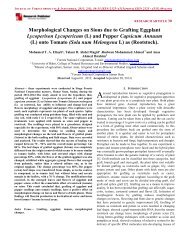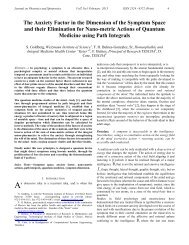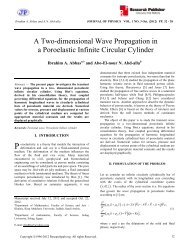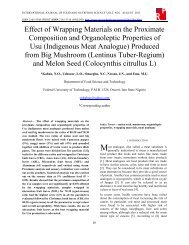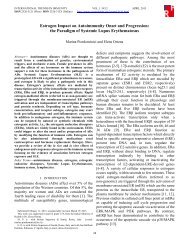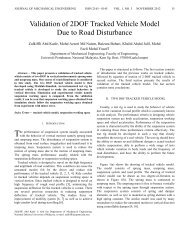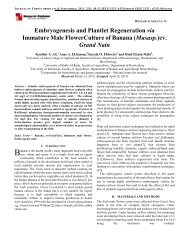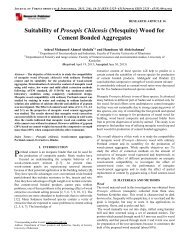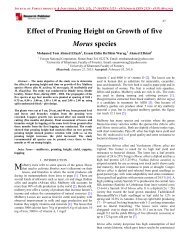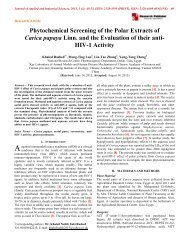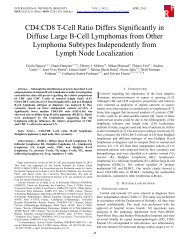Antiviral Activity and Phytochemical Analysis of Ailanthus Excelsa ...
Antiviral Activity and Phytochemical Analysis of Ailanthus Excelsa ...
Antiviral Activity and Phytochemical Analysis of Ailanthus Excelsa ...
You also want an ePaper? Increase the reach of your titles
YUMPU automatically turns print PDFs into web optimized ePapers that Google loves.
JOURNAL OF FOREST PRODUCTS & INDUSTRIES, 2013, 2(3), 30-33 ISSN:2325–4513(PRINT) ISSN 2325 - 453X (ONLINE)RESEARCH ARTICLE 30<strong>Antiviral</strong> <strong>Activity</strong> <strong>and</strong> <strong>Phytochemical</strong> <strong>Analysis</strong> <strong>of</strong><strong>Ailanthus</strong> <strong>Excelsa</strong> Roxb Bark* Khaled Rashed 1 , Ataa Said 1 , Mohammed Ahmed 21 Pharmacognosy Department, 2 Virology Department, National Research Centre, Dokki, Giza, Egypt.*Corresponding author: Dr. Khaled Nabih Zaki Rashed, Tel: 01003642233E-mail: khalednabih2015@yahoo.co.uk(Received March 20, 2013; Accepted April 25, 2013)Abstract— Resistance to current anti-herpetic drugs has beenincreasingly reported, so there is a need for discovering newantiviral agents, in particular from natural origin. The aim <strong>of</strong> thepresent study is to investigate chlor<strong>of</strong>orm <strong>and</strong> methanol (70%)extracts from <strong>Ailanthus</strong> excelsa bark for their antiviral activityagainst Herpes Simplex virus type 1 (HSV-1) using Plaquereduction assay. The results has shown that chlor<strong>of</strong>orm extract <strong>of</strong><strong>Ailanthus</strong> excelsa has a significant anti-viral activity againstherpes Simplex virus type 1 in-vitro by 82.6% at concentration <strong>of</strong>50 µg, while methanol 70% extract was less active. <strong>Phytochemical</strong>analysis <strong>of</strong> both Chlor<strong>of</strong>orm <strong>and</strong> methanol extracts <strong>of</strong> <strong>Ailanthus</strong>excelsa has shown that it has interesting bioactive compoundsinclude quassinoids (highly oxygenated triterpenes) <strong>and</strong> alkaloids<strong>and</strong> further phytochemical analysis from bio-active chlor<strong>of</strong>ormextract resulted the isolation <strong>of</strong> the major alkaloid compound,canthin-6-one. In conclusion, <strong>Ailanthus</strong> excelsa extracts may bean appropriate c<strong>and</strong>idate for further development <strong>of</strong> anti-HSV-1infection.Index Terms— <strong>Ailanthus</strong> excelsa, antiviral activity, quassinoids,alkaloids, canthin-6-one.VI. INTRODUCTIONiral infections, particularly the infections caused by herpessimplex virus (HSV), represent one <strong>of</strong> the most seriouspublic health concerns globally because <strong>of</strong> theirdevastating impact. Herpes simplex virus type 1 (HSV-1) is acommonly occurring human pathogen worldwide. There is anurgent need to discover <strong>and</strong> develop new agents for themanagement <strong>of</strong> HSV-1 infection. Since the ancient times,natural products has served as a major source <strong>of</strong> drugs. Aboutfifty percent <strong>of</strong> todays pharmaceutical drugs are derived fromnatural origin [1]. Also it is well established that naturalproducts are an excellent source <strong>of</strong> chemical compounds with awide variety <strong>of</strong> biological activities including antiviral <strong>and</strong>anticancer properties [2]. In our searching for new antiviralsubstances from plants, in particular from Simaroubaceaefamily, A. excelsa Roxb is a tree <strong>of</strong> rapid growth <strong>and</strong> is calledtree <strong>of</strong> heaven, leaves appear in March-April, 30-90 cm long,pinnate, the flowers, small in size, yellow in colour <strong>and</strong>*Corresponding author.arranged in panicles <strong>and</strong> the fruits are formed soon afterflowering. The fruits ripen in May-June, just before the onset <strong>of</strong>monsoon. A. excelsa was investigated previously to proveantibacterial [3], antifungal [4], Antifertility [5] <strong>and</strong> anticancer[6]. A. excelsa is used in treatment <strong>of</strong> skin erpution <strong>and</strong> for thecure <strong>of</strong> wounds, The bark is bitter, astringent, anthelmentic,febrifuge, appetizer, bitter tonic, taste bud stimulant, It is usefulin diarrhea, amoebic dysentery, chronic giardiasis, dyspepsia,abdominal spasm anorectal disease, haemorrhoids, fistula,fissures, ulcerative colitis as mentioned in traditional medicine[7] From chemical point <strong>of</strong> view the plant is a rich source <strong>of</strong>alkaloids [8, 9] proteins [10], quassinoids [11, 12] <strong>and</strong>flavonoids were isolated from leaves [13]. In the present study,we investigated antiviral activity <strong>of</strong> chlor<strong>of</strong>orm <strong>and</strong> methanolextracts from A. excelsa bark against Herpes Simplex virus type1 (HSV-1) in-vitro <strong>and</strong> also determined the major compound inthe bioactive chlor<strong>of</strong>orm extract.II. MATERIALS AND METHODSPlant MaterialA. excelsa bark was collected from Zoo garden, Giza, Egypt inMay 2010. The plant was identified by Dr. Mohamed El-Gabaly, Pr<strong>of</strong>essor <strong>of</strong> Taxonomy, National Research Centre. Avoucher specimen no. 13241 is deposited in the herbarium <strong>of</strong>Zoo garden, Giza, Egypt.Preparation <strong>of</strong> extracts <strong>and</strong> isolation <strong>of</strong> the major compound<strong>of</strong> chlor<strong>of</strong>orm extractThe Air dried powered bark <strong>of</strong> A. excelsa 400 g wassuccessively extracted with Chlor<strong>of</strong>orm <strong>and</strong> methanol70% bymaceration for 24 hours <strong>and</strong> each extract was concentratedunder reduced pressure to give 15 g <strong>and</strong> 23 g <strong>of</strong> crude extracts,respectively. Each extract <strong>of</strong> A. excelsa was phytochemicallyscreened according to the following described by (Connolly etal. 1970) [14] for sterols <strong>and</strong>/or triterpenes (quassinoids); Wolfet al. 1962) [15] for carbohydrates <strong>and</strong> saponins; Harbone1973) [16] for flavonoids <strong>and</strong> alkaloids; Farnsworth 1966)[17] for coumarins; Geissman 1962 for tannins [18]Confirmation <strong>of</strong> the presence <strong>of</strong> quassinoids <strong>and</strong> alkaloidswere detected by Thin layer chromatography (TLC) byspraying with specific reagents. Chromatographic separation<strong>of</strong> chlor<strong>of</strong>orm extract on silical gel column chromatography(0.06-0.2 mm) eluted with chlor<strong>of</strong>orm: methanol (99:1)
JOURNAL OF FOREST PRODUCTS & INDUSTRIES, 2013, 2(3), 30-33 ISSN:2325–4513(PRINT) ISSN 2325 - 453X (ONLINE)31resulted in the isolation <strong>of</strong> major compound <strong>of</strong> the chlor<strong>of</strong>ormextract, canthin-6-one, detection <strong>of</strong> this compound wasdetected by sparing with dragendr<strong>of</strong>f reagent which is specificfor alkaloids on TLC in which the compound gave red-orangespot.Preparation <strong>of</strong> the extracts for bioassayExtracts were dissolved as 100 mg in 1 ml <strong>of</strong> 10% DMSO inwater. The final concentration was 100 µg/ µl (Stock solution).The dissolved solutions were sterilized by addition <strong>of</strong>antibiotic antimycotic mixture [19] Sterility test were carriedout in nutrient agar.Cell CultureAfrican green monkey kidney-derived cells (VERO) wereused. The cells were propagated in Hanks ٫ Minimum essentialmedium, MEM supplemented with 10% Foetal bovine serum,1% antibiotic-antimycotic mixture. The pH was adjusted at7.2-7.4 by 7.5% sodium bicarbonate solution. The mixture wassterilized by filtration through 0.2 µm pore size nitrocellulosemembrane.VirusesHerpes Simplex virus type 1 was obtained from EnvironmentalVirology Lab., Department <strong>of</strong> Water Pollution Research,National Research Centre. <strong>Antiviral</strong> assay was carried byPlaque reduction assay [20].Plaque reduction assayA 6-well plate was cultivated with Vero cell culture (10 5 cell/ml) <strong>and</strong> incubated for 2 days at 37 C. HSV-1 was diluted togive 10 4 PFU/ml final concentration <strong>and</strong> mixed with the plantextract at 100 mg in 1 ml <strong>of</strong> 10% DMSO in water <strong>and</strong>incubated overnight at 4C. Growth medium was removedfrom the multiwell plate virus-compound mixture wasinoculated (100 µg/well). After 1 hr contact time, the inoculumwas aspirated <strong>and</strong> 3 ml <strong>of</strong> Minimal Essential Medium (MEM)with 1% agarose was overlaid the cell sheets. The plates wereleft to solidify <strong>and</strong> incubated at 37C until the development <strong>of</strong>virus plaques. Cell sheets were fixed in 10% formalinesolution for 2 hrs, <strong>and</strong> stained with crystal violet stain. Controlvirus <strong>and</strong> cells were treated identically without chemicalcompound. Virus plaques were counted <strong>and</strong> the percentages <strong>of</strong>reduction were calculated [20].III. RESULTS AND DISCUSSIONRESULTSThe Results <strong>of</strong> antiviral activity <strong>of</strong> <strong>Ailanthus</strong> excelsa stem barkextracts are included in table 1, it has shown that chlor<strong>of</strong>ormextract is more potent than methanol extract as anti-HSV-1agent, where chlor<strong>of</strong>orm extract showed virus reduction by82.6, while methanol extract showed virus reduction by 52 atthe concentration <strong>of</strong> 50 µg. <strong>Phytochemical</strong> analysis <strong>of</strong> theextracts are included in table 2 which prove that each extracthas interesting bio-active compounds, quassinoids, <strong>and</strong>alkaloids <strong>and</strong> the major alkaloid compound, canthin-6-one wasisolated from the bioactive chlor<strong>of</strong>orm extract <strong>and</strong> thechemical structure <strong>of</strong> the compound was identified by 1 H-NMR, 13 C-NMR <strong>and</strong> MSStructure elucidation <strong>of</strong> the alkaloid compound, canthin-6-one:Canthin-6-one: 1 H NMR (400 MHz, CDCl 3 ): H 6.98 (d, J =9.9 Hz, H-5), 7.50 (t, J = 7.6 Hz, H-10), 7.68 (t, J = 7.6 Hz, H-9), 7.95 (d, J = 4.8 Hz, H-1), 8.01 (d, J = 9.9 Hz, H-4), 8.09(d, J = 7.6 Hz, H-11), 8.64 (d, J = 8.1 Hz, H-8), 8.79 (d, J =4.8 Hz, H-2). 13 C NMR (100 MHz, CDCl 3 ): c 116.49 (C-1),117.30 (C-8), 122.74 (C-11), 124.37 (C-11a), 125.72 (C-10),128.95 (C-5), 130.47 (C-11b), 130.95 (C-9), 132.07 (C-11c),136.09 (C-3a), 139.49 (C-4), 139.49 (C-7a), 145.76 (C-2) <strong>and</strong>159.59 (C-6).EI-MS: m/z 220.10911811a7aON11b11c5Figure 1. Canthin-6-oneDISCUSSIONThe present study for the first time, proved antiviral activity <strong>of</strong> A.67excelsa bark extracts. The results has shown that chlor<strong>of</strong>orm hasa good antiviral activity than methanol extract (Table 1) in adose dependent mannar. Chlor<strong>of</strong>orm extract <strong>of</strong> A. excelsa stembark at concentration 20 µg has shown an inhibition for the virusby 66.5%, <strong>and</strong> at concentration <strong>of</strong> 50 µg, chlor<strong>of</strong>orm fraction <strong>of</strong>A. excelsa stem bark has a significant anti-viral activity byinhibition for the virus by 82.6%. Methanol extract atconcentration 20 µg has shown an inhibition for the virus by44.9%, <strong>and</strong> at concentration <strong>of</strong> 50 µg, it has shown inhibition <strong>of</strong>the virus by 52%. The anti-HSV-1 properties <strong>of</strong> A. excelsaextracts in this research could be due to multiple differentcomponents in these extracts. The phytochemicalcharacterization <strong>of</strong> extracts <strong>and</strong> the identification <strong>of</strong> thebioactive compounds are now needed. <strong>Phytochemical</strong> analysis<strong>of</strong> the extracts has shown that both extracts have interestingbioactive compounds include quassinoids <strong>and</strong> alkaloids (Table2). Chlor<strong>of</strong>orm extract contained canthin-6-one as the majorcomponent <strong>and</strong> the higher activity <strong>of</strong> chlor<strong>of</strong>orm extract isprobably due to the higher concentration <strong>of</strong> these bioactivecompounds in the chlor<strong>of</strong>orm extract, while methanol is lessactive due to its low concentrations <strong>of</strong> these bioactivecompounds. <strong>Analysis</strong> <strong>of</strong> both extracts by TLC has proved manyspots for chlor<strong>of</strong>orm extract <strong>and</strong> less number <strong>of</strong> spots formethanol extract <strong>and</strong> these spots were detected under ultraviolet(UV) light. Spraying these spots with vanillin-sulphuric acidreagent followed by heating for 5 min until the appearance <strong>of</strong>purplish-blue colours specific for13a4N23
JOURNAL OF FOREST PRODUCTS & INDUSTRIES, 2013, 2(3), 30-33 ISSN:2325–4513(PRINT) ISSN 2325 - 453X (ONLINE)32quassinoids <strong>and</strong> Spraying with draggendror ' s reagent resulted inthe formation <strong>of</strong> an orange colour specific for alkaloids. TheHSV-1 activity <strong>of</strong> chlor<strong>of</strong>orm extract may be due to thepresence <strong>of</strong> alkaloids (canthin-6-one) <strong>and</strong> quassinoids whichpresent in considerable amounts in the extract [8], [9], [11], [4]<strong>and</strong> this is in agreement with the activity <strong>of</strong> alkaloids isolatedfrom Tripterygium hypoglaucum against herpes simplex virustype1 [21] Also the antiviral activity <strong>of</strong> alkaloids was confirmedTable 1from Fumaria <strong>and</strong> Corydalis species [22] as well Quassinoidshave shown anti-HSV-1 [23] Chlor<strong>of</strong>orm extract <strong>of</strong> A. excelsabark has considerable amounts <strong>of</strong> alkaoids <strong>and</strong> quassionoids<strong>and</strong> the major component is the alkaloid is canthin-6-one whilemethanol has the same bioactive chemical compounds but inless amount, so Chlor<strong>of</strong>orm extract has higher antiviral activitythan methanol.Anti-HSV-1 bioassay in Vero cell line by plaque reduction assay <strong>of</strong> A. excelsa extractsHSV-1ExtractConcentrationInitial virus count(PFU/ml)Virus count(PFU/ml)% <strong>of</strong> Virus reductionChlor<strong>of</strong>orm 20 µg 1.96 x 10 7 1.22 x 10 7 66.550 µg 1.96 x 10 7 1.2 x 10 7 82.6Methanol 20 µg 1.96 x 10 7 1.08 x 10 7 44.950 µg 1.96 x 10 7 0.94 x 10 7 52Table 2Results <strong>of</strong> <strong>Phytochemical</strong> analysis <strong>of</strong> A. excelsa extractsChemical Constituents Chlor<strong>of</strong>orm extract Methanol extractCarbohydrates <strong>and</strong>/or glycosides - +Tanninsa. Condensed tanninsb. Hydrolysable tannins----Alkaloids <strong>and</strong>/or nitrogenous bases ++ +Flavonoids - -Sterols <strong>and</strong>/or triterpenes (Quassinoids) + + +Saponins - -Coumarins - -+ denotes the presence <strong>of</strong> the constituents- denotes the absence <strong>of</strong> the constituents
JOURNAL OF FOREST PRODUCTS & INDUSTRIES, 2013, 2(3), 30-33 ISSN:2325–4513(PRINT) ISSN 2325 - 453X (ONLINE)33VI. CONCLUSION<strong>Ailanthus</strong> excelsa bark Chlor<strong>of</strong>orm extract can be as a promisingsource as antiviral agent <strong>and</strong> this is due to the presence <strong>of</strong> theinteresting bioactive phytoconstituents as quassinoids <strong>and</strong>alkaloids (canthin-6-one ) <strong>and</strong> it may be appropriate for furthertherapeutic studies against herpes viruses.Conflict <strong>of</strong> interestThere is no conflict <strong>of</strong> interest associated with the authors <strong>of</strong> thispaper.REFERENCES[1] Clark, A. M. (1996). Natural Products as a Resource for New Drugs.Pharmaceutical Research 13: 1133-1141.[2] Cragg, G. M. <strong>and</strong> Newman, D. J. (2005). Plants as a source <strong>of</strong> anticanceragents. Journal <strong>of</strong> Ethanopharmacology 100: 72-79.[3] Shrimali, M., Jain, D. C., Darokar, M. P., Sharma, R. P. (2001).Antibacterial activity <strong>of</strong> <strong>Ailanthus</strong> excelsa (Roxb.). Phytotherapy Research15:165-166.[4] Joshi, B. C., P<strong>and</strong>ey, A., Sharma, R. P, Khare, A. (2003b). Quassinoidsfrom <strong>Ailanthus</strong> excelsa Phytochemistry 62: 579-584.[5] Dhanasekaran, S., Suresh, B., Sethuraman, M., Rajan, S. <strong>and</strong> Dubey, R.,(1993). Antifertility activity <strong>of</strong> <strong>Ailanthus</strong> excelsa Linn in female albino rats.Indian Journal <strong>of</strong> Experimental Biology 31:384-391.[6] Ogura, M., Cordell, G. A., Kinghorn, A. D., Farnsworth, N. R. (1977).Potential anticancer agents VI. Constituents <strong>of</strong> <strong>Ailanthus</strong> excelsa(Simaroubaceae). Lioydia 40: 579-584.[7] Asolkar, L. V., Kakkar, K. K., Chakre O. J. (1992) “ Glossary <strong>of</strong> IndianMedicinal Plants with Active Principles ” , C.S.I.R., New Delhi, Part-I, pp. 34-58.[8] Cordell GA, Ogura M, Farnsworth NR. (1978). Alkaloids constituents <strong>of</strong><strong>Ailanthus</strong> excelsa. Lioydia 41, 166- 168.[9] Said A., Rashed K., Tokuda H., Huefner A.(2012). Antitumor activity <strong>of</strong><strong>Ailanthus</strong> excelsa Roxb. stem bark fractions <strong>and</strong> <strong>of</strong> canthin-6-one. IUFSJournal <strong>of</strong> Biology 71(1): 112-121.[10] Nag A, Matai S. (1994). <strong>Ailanthus</strong> excelsa Roxb. (Simaroubaceae), apromising source <strong>of</strong> leaf protein. Journal <strong>of</strong> Agriculture <strong>and</strong> Food Chemistry,35: 1115-1117.[11] Khan, S. A, Shamsuddin, K. M. (1980). Glaucarubol from <strong>Ailanthus</strong>excelsa. Phytochemistry 19:2484-2485.[12] Joshi, BC., Pendey, A, Chaurasia L., Pal M., Sharma R. P., Khare A.(2003a). Antifungal activity <strong>of</strong> the stem bark <strong>of</strong> <strong>Ailanthus</strong> excelsa.Fitotherpia 74:689-691.[13] Said A, Tundis R, Hawas WU, El-Kousy S, Rashed K, Menichini F,Bonesi M, Huefner A, Monica RL, Menichini F. (2010). In vitro Antioxidant<strong>and</strong> antiproliferative activities <strong>of</strong> flavonoids from <strong>Ailanthus</strong> excelsa (Roxb)(Simaroubaceae) leaves. Z. Naturforsch, 65c, 180-186.[14] Connolly J. D, Overton K. H, Polonsky J. (1970). The chemistry <strong>and</strong>biochemistry <strong>of</strong> the linonoids <strong>and</strong> quassinoids. In: Reinhold l, Liwashitz Y(eds) Progress in phytochemistry. Wiley, London, pp 385-412.[15] Wolf, H. H, Swinyard E. A, Goodman L. S. (1962). Anticonvulsantproperties <strong>of</strong> some N-substituted hydanoins. J Phrama Sci 51:74-76.[16] Harbone, J. B. (1973). <strong>Phytochemical</strong> methods. Chapman & Hall,London, pp.40-107.[17] Farnsworth, N. R (1966). Biological <strong>and</strong> phytochemical screening <strong>of</strong>plants. Journal <strong>of</strong> Pharmceutical Sciences 55, 225-276.[18] Geissman, T.A. (1962). The Chemistry <strong>of</strong> flavonoids compounds.Pergamon, London, pp.126-147.[19] Arisawa, M., Hayashi K, Nikaido T, Koike K, Fujita D, Nunomura N,Tanaka, M, Sasaki T. (1997). International J. <strong>of</strong> Pharmacology 35 (1):6-14.[20] Husing, G. D, Melnick J. L. (1957). Morphologic characteristics <strong>of</strong>plaques produced on monkey kidney monolayer cultures by enteric viruses(poliomyelitis, Coxsackie, <strong>and</strong> echo groups. Journal <strong>of</strong> Immunology78:128-135.[21] Ren Z, Zhang C. H, Wang L. J, Cui Y. X, Qi R. B, Yang C. R, Zhang Y.J, Wei X.Y, Lu D. X, Wang Y. F. (2010). In vitro anti-viral activity <strong>of</strong> thetotal alkaloids from Tripterygium hypoglaucum against herpes simplex virustype 1. Virologica sinica 25:107-114.[22] IIkay O, Berrin Ozcelik, Taner K, Bilge S. (2007). <strong>Antiviral</strong> activity <strong>of</strong>alkaloids isolated from Fumaria <strong>and</strong> Corydalis species. Z. Naturforsch, 62c,19-26.[23] Nugraha, A.S, Keller P.A. (2011). Revealing indigenous Indonesiantraditional medicine: anti-infective agents. Natural Product Communications6 (12):1953-1966.



